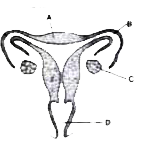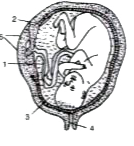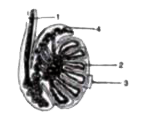Complete Solutions to REVIEW Questions of chapter REPRODUCTIVE SYSTEM of Class 10 book with complete answers and questions
| Class 10 | BIOLOGY |
| Chapter | REPRODUCTIVE SYSTEM |
| EVERGREEN PUBLICATION | REVIEW Questions |
| Number Of Questions | 100 |
| Academic Year | 2023-24 |
Name the following :
The cells that secrete testosterone hormone in males.03:07View SolutionName the following :
The canal through which the testes descend into scrotum just before birth01:52View SolutionName the following :
The structure that keeps the testes in their position01:05View SolutionName the following :
The peritoneum that attaches ovaries with the abdominal wall.03:17View SolutionName the following :
The fully developed part of ovary containing egg.01:18View SolutionName the following :
The tubular structure present on the upper end and side of the testes.01:13View SolutionName the following :
The accessory gland in human males whose secretion activates the sperms.01:09View SolutionName the following :
The part of female reproductive system where development of foetus is completed.02:16View SolutionName the following :
The structure that produces testosterone.01:29View SolutionName the following :
The place where fertilisation occur in the female reproductive system.01:58View SolutionName the following :
The structure formed by the villi of the embryo and the uterus of the mother.01:11View SolutionName the following :
The structure which connects the placenta and the foetus.01:07View SolutionState whether true or false. If false, write correct statement:
Fertilisation takes place in the uterus.01:05View SolutionState whether true or false. If false, write correct statement:
Lower sperm counts cause infertility in males.01:09View SolutionState whether true or false. If false, write correct statement:
Gestation period in human beings is about aweek02:04View SolutionState whether true or false. If false, write correct statement:
Implantation takes place immediately after fertilisation.01:29View SolutionState whether true or false. If false, write correct statement:
In human beings, if fertilisation does not occur, the egg develops parthenogenetically.01:37View SolutionState whether true or false. If false, write correct statement:
Vasectomy is the surgical method of sterilization in men.02:13View SolutionState whether true or false. If false, write correct statement:
Process of fusion of the sperm nucleus and the egg nucleus is termed implantation.02:37View SolutionState whether true or false. If false, write correct statement:
Tubectomy is the surgical method of sterilization in males.02:27View SolutionState whether true or false. If false, write correct statement:
Gestation is the process of fixing of the zygote to the uterine wall.02:31View SolutionFind the odd one out and name the category :
Endometrium, cervix, fimbriae and fundus.03:07View SolutionFind the odd one out and name the category :
Tunica albuginea, lobule, vas deferens, seminiferous tubules and Leydig's cells.05:04View SolutionFind the odd one out and name the category :
Binary fission, gonads, budding, multiple fission and fragmentation.01:39View SolutionFind the odd one out and name the category :
Ovary, ureter, fallopian tube, uterus.01:33View SolutionFind the odd one out and name the category :
Seminal vesicles, epididymes, vasa deferentia, ejaculatory duct and urethra.00:54View SolutionFind the odd one out and name the category :
Prostate gland, seminal vesicles, Cowper's glands and scrotum.01:58View SolutionFind the odd one out and name the category :
Ovaries, oviducts, uterus, vagina and vulva.03:08View SolutionFind the odd one out and name the category :
Labia majora, labia minora, vagina, vestibule and clitoris.02:53View SolutionFind the odd one out and name the category :
Prostate gland, Cowper's gland, seminal vesicle, seminiferous tubules.02:56View SolutionComplete the following sentences :
A single ejaculation in man contains about ............... sperms.00:52View SolutionComplete the following sentences :
Hypothetically if all the eggs that mature in the ovaries of a woman develop into young ones, the maximum number of children produced by a woman will be .....04:29View SolutionComplete the following sentences :
In a male sterility ............................... fails to fertilise ............02:39View SolutionComplete the following sentences :
Attachment of developing embryo with the uterus is called …................01:31View SolutionComplete the following sentences :
…............... is the birth of child02:10View SolutionComplete the following sentences :
…...................... is the onset of menstrual cycle at puberty and ................................. is the complete cessation of menstrual cycle.01:14View SolutionComplete the following sentences :
............ is the failure to attain erection whereas ............ is the failure to fertilise an egg.01:55View SolutionComplete the following sentences :
The period of complete development of the foetus till birth is termed ...............01:37View SolutionComplete the following sentences :
Corpus luteum and …......................02:50View SolutionDefine the following:
Menarche01:24View SolutionDefine the following:
Menopause01:17View SolutionDefine the following:
Parthenogenesis01:25View SolutionDefine the following:
Puberty02:40View SolutionDefine the following:
Parturition02:06View SolutionDefine the following:
Gestation period02:04View SolutionDifferentiate between :
Asexual and Sexual reproduction03:11View SolutionDifferentiate between :
Infertility and Impotence03:41View SolutionDifferentiate between :
Menarche and Menopause03:53View SolutionDifferentiate between :
Essential and Accessory organs03:55View SolutionDifferentiate between :
Corpus callosum and Corpus luteum (Function)02:34View SolutionDifferentiate between :
Tubectomy and Vasectomy (Part cut and tied).01:49View SolutionDifferentiate between :
Sperm duct and fallopian tube (Function).01:59View SolutionDifferentiate between :
Testosterone and Oestrogen (organ which secretes]00:59View SolutionWhat are the functions of the following:
Oviducts01:19View SolutionWhat are the functions of the following:
Uterus01:58View SolutionWhat are the functions of the following:
Vagina01:42View SolutionWhat are the functions of the following:
Interstitial cells01:49View SolutionWhat are the functions of the following:
Prostate gland01:12View SolutionWhat are the functions of the following:
Vas deferens01:24View SolutionWhat are the functions of the following:
Sperm duct01:33View SolutionWhat are the functions of the following:
Leydig's cell01:52View SolutionWhat are the functions of the following:
Corpus luteum04:51View SolutionWhat are the functions of the following:
Seminal Vesicles02:39View SolutionHow does the sperm reach up to the egg and how does it enter into the egg?
05:04View SolutionWhat is sexual dimorphism ? How can you say that human beings exhibit sexual dimorphism ?
01:17View SolutionComment upon the following:
Blood of mother and foetus never mix with each other, but there is always some barrier between the two.03:19View SolutionComment upon the following:
A single sperm fertilises an ovum, still more than 300 million sperms are present in each ejaculation.01:03View SolutionComment upon the following:
At the time of birth, the testes descend down into the scrotal sac.01:49View SolutionComment upon the following:
Gametes are always haploid.01:03View SolutionComment upon the following:
Margins of fallopian funnels are fimbriated and bear cilia.03:16View SolutionComment upon the following:
Twins may or may not be identical.01:30View SolutionComment upon the following:
When an ovum getsfertilised, menstrual cycle stops temporarily in a woman?03:48View SolutionComment upon the following:
The placenta is an important structure for the development of a foetus.03:03View SolutionTrace the path of sperm from its formation in the seminiferous tubules up to ejaculation.
03:45View SolutionGiven below is a diagram of the reproductive system of a human female :

(i) Name the parts numbered 1-6.
(ii) Normally after how many days does an ovary release an egg?
(iii) Where are the sperms released during coitus?
(iv) What do the sperms do after being released ?
(V) What is the function of the organ numbered 5 ?
(vi) How many days does it normally take from the fertilisation of the egg up to the birth of the baby?05:42View SolutionThe figure given below represents the female reproductive system of a mammal. Parts indicated by the guidelines A to D are as follows:

(A) Uterus
(B) Fallopian tube (oviduct)
(C) Ovary
(D) Vagina
(a) Give appropriate terms for each of the following:
(i) The onset of reproductive phase in a young female.
(ii) Rupture of follicle and release of ovum from the ovary
(iii) Monthly discharge of blood and disintegrated tissues in human female.
(iv) Process of fusion of ovum and sperm.
(v) Fixing of developing zygote on the uterine wall.
(vi) The permanent stoppage of menstruation at about the age of 45 years in a female.
(b) State the functions of the (0) Placenta (ii) Amniotic fluid. [ICSE 2004, 2015]
(c) Using the symbol "X' indicates the region in the diagram where fertilisation occurs.[ICSE 2004)04:38View Solution(a) The diagram given below is that of a developing human foetus in the womb. Study the same and then answer the questions that follow :

(i) Name the parts '1' and '5' indicated by guidelines.
(ii) What term is given to the period of development of the foetus in the womb ?
(iii) How many days does the foetus take to be fully developed ?
(iv) Mention two functions of the part labelled 2 other than its endocrine function.
(v) Name the hormone (any one) produce by the part labelled 2
(vi) What is the function of the part marked 3 ?
(b) Give the exact location of amnion.
[ICSE 2011, 2014]03:37View SolutionGiven below is the outline of the cross-section of the male reproductive system :

(i) Copy the outline on to your answer sheet with pencil and label the following parts testis, epididymis, seminal vesicles, vas deferens
(ii) Name the hormone produced by the testis.
(iii) Why are sperms produced in large numbers?
(iv) State the function of the seminal vesicles.05:12View SolutionRewrite the following in correct order as to be in a logical sequence :
Penis, testis, sperm duct, sperm, semen.02:23View SolutionRewrite the following in correct order as to be in a logical sequence :
Implantation, fertilisation, ovulation, gestation.03:07View SolutionRewrite the following in correct order as to be in a logical sequence :
Seminiferous tubule, sperm, sperm duct, accessory glands, semen, urethra.02:15View SolutionRewrite the following in correct order as to be in a logical sequence :
Vagina, ovary, uterus, oviduct, cervix (Pathway of egg after ovulation).02:10View SolutionRewrite the following in correct order as to be in a logical sequence :
Implantation parturition, ovulation, gestation fertilisation (stages leading to formation of foetus and birth).03:22View SolutionRewrite the following in correct order as to be in a logical sequence :
Seminiferous tubule, penis, urethra, epididymis, vas deferens (course of passage of sperms in man)03:25View SolutionRewrite the following in correct order as to be in a logical sequence :
Uterus, Parturition, Fertilisation, Gestation, Implantation.04:59View SolutionGive the exact location and one function of the following:
Seminiferous tubule.03:46View SolutionGive the exact location and one function of the following:
Prostate gland.03:25View SolutionGive the exact location and one function of the following:
Epididymis02:44View SolutionGive the exact location and one function of the following:
Testis01:54View SolutionGive the exact location and one function of the following:
Thylakoids02:51View SolutionRewrite and complete the second pair :
Uterus : Implantation :: Fallopian tube : ............03:47View SolutionRewrite and complete the second pair :
Placenta : ........01:20View SolutionThe diagram given below is the internal section of a testis of man. Study it carefully and answer the questions that follow:

(i) Label the parts 1 to 4 of the diagram.
(ii) State the functions of the parts labelled 1 and 2.
(iii) Draw a labelled diagram of a sperm.03:50View SolutionGive technical term :
Onset of menstruation in a young girl around the age of 13 years.02:29View SolutionGive technical term :
The mucus membrane lining the uterus.01:59View SolutionGive technical term :
Cessation of menstruation in females.01:27View SolutionGive technical term :
Period of complete intrauterine development of the embryo.01:35View SolutionGive technical term :
Non-identical twins produced by the fertilisation of two eggs.01:24View SolutionGive technical term :
Membrane that protects the foetus and secretes protective fluid.01:25View SolutionGive technical term :
The phase in the menstrual cycle in which the remnant of follicle in the ovary turns into corpus luteum.02:09View Solution
REVIEW Questions questions and complete solutions for chapter REPRODUCTIVE SYSTEM of EVERGREEN BIOLOGY (ENGLISH) of Class 10
